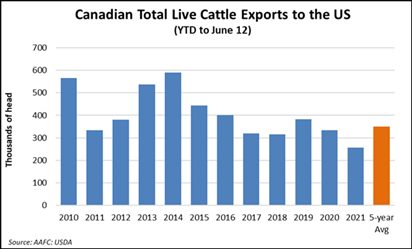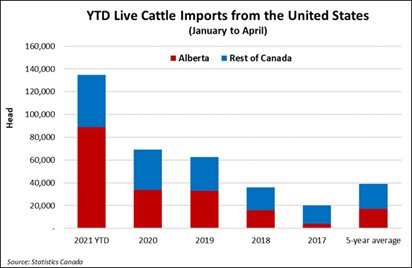Year-to-date cattle exports are at one of the lowest levels in 15 years, while imports are increasing.
‘Canadian cattle exports for the first half of 2021 are down 23% compared to 2020 and 26% lower than the 5-year average,’ says Jason Wood, livestock market analyst with Alberta Agriculture and Forestry. ‘Year-to-date, Canadian cattle exports in 2021 are the lowest in about 15 years.’
Wood says the decline in cattle exports has been influenced by a number of factors. These include expansion of the U.S. cattle herd over a 6-year period starting in 2014. The US beef cow inventory increased by over 2.6 million head, reducing the need for imported live cattle. Since 2014, the Canadian beef cow herd has declined by 297,000 head, reducing the available supply of cattle for export. Canadian cattle processing capacity and plant utilization levels have also increased, supporting growth in the Canadian cattle feeding industry and demand for cattle.
Image 1. Canadian total live cattle exports to the United States

In 2020, live Canadian cattle exports were 669,670 head, down 7% from 2019 and 6% lower than the 5-year average. Canadian live cattle exports to the U.S. have been trending lower, with 2020 being 46% lower than 2014. Feeder cattle exports for 2020 were down 36% from 2019 and 73% below 2014.
Slaughter capacity
Weekly federally inspected Canadian cattle slaughter capacity is approximately 66,860 head. In the west, federally inspected cattle slaughter capacity is just over 51,000 head or 76% of Canadian capacity.
The national federally inspected beef plant utilization rate was 92% in 2019. Western Canada federally inspected cattle slaughter plants had an average utilization rate of 93.4% in 2019. For 2020, the western Canada utilization rate averaged 89.6%, including 6 weeks in April and May when weekly utilization rates were below 70% due to COVID-19 plant disruptions.
Removing the 6-week disruption period increases the utilization rate for western Canada beef slaughter plants to 96.3% in 2020. The utilization rates indicate plants are running near capacity and significantly higher than the 5-year average of 83%.
Cattle imports
‘The demand for cattle has turned Canada into a net importer of feeder cattle in recent years,’ explains Wood. ‘For the January to April 2021 period, 134,660 head have been imported from the U.S., an increase of 95% from 2020 and more than double 2019. Alberta cattle imports from the U.S. are 88,870 head for the January to April period, an increase of 165% from 2019.’
In 2021, Alberta cattle imports accounted for 66% of total Canadian cattle imports, compared to an average of 44% over the last 5 years. For the January to April 2021 period, Canada’s net cattle imports are about 100,000 head, up significantly from a year ago.
Image 2. Live cattle imports from the United States

Source : alberta